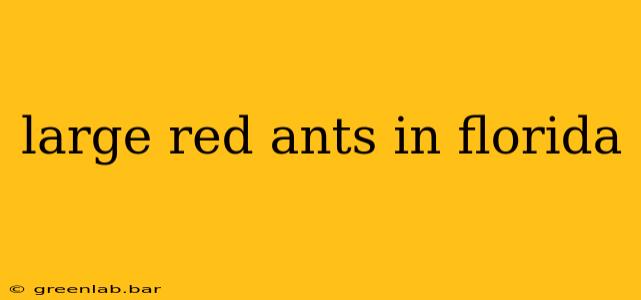Florida's warm climate provides a haven for a variety of ant species, some of which are quite large and strikingly red. These ants can be a nuisance, invading homes and gardens, and understanding how to identify and manage them is crucial for homeowners. This guide will delve into the common large red ants found in Florida, offering detailed descriptions, effective control methods, and preventative measures to keep these insects at bay.
Identifying Large Red Ants in Florida
Several ant species in Florida exhibit a reddish hue and substantial size. Distinguishing between them is important, as control strategies can vary. Here are some common culprits:
1. Florida Carpenter Ant ( Camponotus floridanus)
-
Appearance: These ants are among the largest you'll find in Florida, reaching up to ½ inch in length. They're typically black or dark brown, but some colonies can exhibit reddish-brown coloration, especially the workers. Their thorax is distinctly pronounced.
-
Behavior: They nest in wood, but unlike termites, they don't consume the wood itself. Instead, they excavate galleries for nesting purposes. They often build nests in damp or decaying wood, which can lead to structural damage if left unchecked.
-
Habitat: Found in both wooded areas and urban settings. They're attracted to moisture and sources of food.
2. Red Imported Fire Ant ( Solenopsis invicta)
-
Appearance: While not always uniformly red, these ants are characterized by their reddish-brown color and a relatively smaller size compared to carpenter ants. Their size ranges from ⅛ to ¼ inch. They are also readily identifiable by their aggressive behavior.
-
Behavior: These ants are notoriously aggressive and deliver a painful sting. Their mounds are readily visible, often disrupting lawns and gardens.
-
Habitat: Widely distributed across Florida and known for their adaptable nature.
3. Other Reddish Ants:
Several other ant species in Florida can appear reddish-brown, though usually smaller than the two described above. Accurate identification often requires closer examination and may necessitate consultation with a pest control professional. Accurate identification is vital for choosing the appropriate control methods.
Effective Control and Management Strategies
The approach to managing large red ants depends on the specific species and the severity of the infestation.
1. Baiting:
This is generally the most effective method, especially for carpenter ants and fire ants. Bait stations containing slow-acting insecticides attract the ants, who then carry the poison back to the nest, eliminating the entire colony. Place baits strategically near ant trails and nesting sites.
2. Insecticidal Sprays:
Sprays can provide immediate relief from foraging ants, but they are often less effective against the entire colony. They target visible ants, but not the queen and the majority of the nest. Always follow label instructions and use appropriate personal protective equipment.
3. Professional Pest Control:
For severe infestations or if you're unable to identify the ant species, contacting a qualified pest control professional is advisable. They possess the expertise and tools to effectively eliminate the infestation and prevent future occurrences.
Prevention:
Proactive measures are crucial in preventing large red ant infestations:
- Eliminate Food Sources: Clean up spills promptly, store food properly, and keep counters clean.
- Reduce Moisture: Repair leaks, address standing water, and ensure proper ventilation to discourage ant nesting.
- Seal Entry Points: Caulk cracks and crevices in walls and foundations to prevent ants from entering your home.
- Maintain Landscaping: Keep grass trimmed, remove leaf litter, and avoid piling firewood near the house.
Conclusion:
Large red ants in Florida can be a persistent problem, but with proper identification and a strategic approach, their impact can be significantly minimized. Understanding the species, employing appropriate control methods, and implementing preventive measures will help protect your home and garden from these unwanted guests. Remember, always prioritize safety when dealing with pest control, and don't hesitate to consult a professional when needed.

